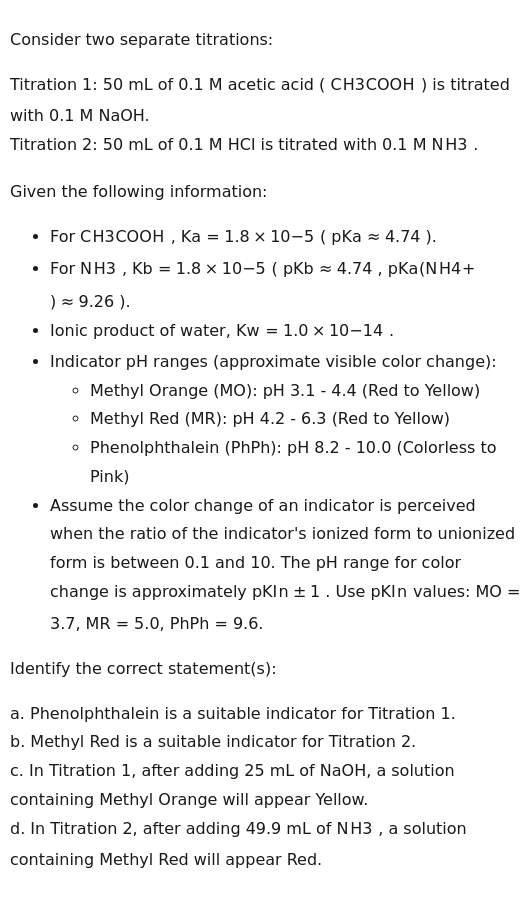Question
Question: Consider two separate titrations: Titration 1: 50 mL of 0.1 M acetic acid ($CH_3COOH$) is titrated ...
Consider two separate titrations:
Titration 1: 50 mL of 0.1 M acetic acid (CH3COOH) is titrated with 0.1 M NaOH. Titration 2: 50 mL of 0.1 M HCl is titrated with 0.1 M NH3.
Given the following information:
- For CH3COOH, Ka=1.8×10−5 (pKa≈4.74).
- For NH3, Kb=1.8×10−5 (pKb≈4.74, pKa(NH4+)≈9.26).
- Ionic product of water, Kw=1.0×10−14.
- Indicator pH ranges (approximate visible color change):
- Methyl Orange (MO): pH 3.1 - 4.4 (Red to Yellow)
- Methyl Red (MR): pH 4.2 - 6.3 (Red to Yellow)
- Phenolphthalein (PhPh): pH 8.2 - 10.0 (Colorless to Pink)
- Assume the color change of an indicator is perceived when the ratio of the indicator's ionized form to unionized form is between 0.1 and 10. The pH range for color change is approximately pKIn±1. Use pKIn values: MO = 3.7, MR = 5.0, PhPh = 9.6.
Identify the correct statement(s):

Phenolphthalein is a suitable indicator for Titration 1.
Methyl Red is a suitable indicator for Titration 2.
In Titration 1, after adding 25 mL of NaOH, a solution containing Methyl Orange will appear Yellow.
In Titration 2, after adding 49.9 mL of NH3, a solution containing Methyl Red will appear Red.
(A), (B), (C), (D)
Solution
Let's analyze each titration and option:
Titration 1: 50 mL 0.1 M CH3COOH vs 0.1 M NaOH (Weak Acid vs Strong Base)
-
Equivalence Point: Moles of CH3COOH=50×0.1=5 mmol. Moles of NaOH needed = 5 mmol. Volume of NaOH needed = 5 mmol / 0.1 M = 50 mL. Total volume = 100 mL. At equivalence, the solution contains 5 mmol of CH3COONa in 100 mL, so [CH3COONa]=0.05 M. CH3COONa is a salt of a weak acid and strong base, so the solution will be basic due to hydrolysis of CH3COO−. CH3COO−+H2O⇌CH3COOH+OH− Kh=Kw/Ka=10−14/(1.8×10−5)≈5.56×10−10. [OH−]=C×Kh=0.05×5.56×10−10=2.78×10−11≈5.27×10−6 M. pOH=−log(5.27×10−6)≈5.28. pH=14−pOH=14−5.28=8.72. The equivalence point for Titration 1 is at pH ≈8.72.
-
Option A: Suitability of Phenolphthalein for Titration 1. The pH range of PhPh is 8.2 - 10.0. The equivalence point pH (8.72) falls within this range. The steep part of the titration curve for a weak acid-strong base titration occurs around the equivalence point pH. Since the equivalence point pH falls within the indicator's range, Phenolphthalein is a suitable indicator for Titration 1. Therefore, option (A) is correct.
-
Option C: Color of Methyl Orange after adding 25 mL NaOH in Titration 1. 25 mL NaOH is half the equivalence volume (50 mL). At the half-equivalence point, [CH3COOH]=[CH3COO−]. This forms a buffer solution. pH=pKa+log[CH3COOH][CH3COO−]=pKa+log(1)=pKa=4.74. The pH of the solution after adding 25 mL NaOH is 4.74. The pH range for Methyl Orange color change is 3.1 - 4.4 (Red to Yellow). At pH 4.74, which is above the upper limit of the range (4.4), the indicator will be predominantly in its basic (ionized) form, which is Yellow. Therefore, option (C) is correct.
Titration 2: 50 mL 0.1 M HCl vs 0.1 M NH3 (Strong Acid vs Weak Base)
-
Equivalence Point: Moles of HCl = 50 \times 0.1 = 5 mmol. Moles of NH3 needed = 5 mmol. Volume of NH3 needed = 5 mmol / 0.1 M = 50 mL. Total volume = 100 mL. At equivalence, the solution contains 5 mmol of NH4Cl in 100 mL, so [NH4Cl]=0.05 M. NH4Cl is a salt of a strong acid and weak base, so the solution will be acidic due to hydrolysis of NH4+. NH4++H2O⇌NH3+H3O+ Kh=Kw/Kb=10−14/(1.8×10−5)≈5.56×10−10. [H3O+]=C×Kh=0.05×5.56×10−10=2.78×10−11≈5.27×10−6 M. pH=−log(5.27×10−6)≈5.28. The equivalence point for Titration 2 is at pH ≈5.28.
-
Option B: Suitability of Methyl Red for Titration 2. The pH range of Methyl Red is 4.2 - 6.3. The equivalence point pH (5.28) falls within this range. The steep part of the titration curve for a strong acid-weak base titration occurs around the equivalence point pH. Since the equivalence point pH falls within the indicator's range, Methyl Red is a suitable indicator for Titration 2. Therefore, option (B) is correct.
-
Option D: Color of Methyl Red after adding 49.9 mL NH3 in Titration 2. Moles of HCl = 5 mmol. Moles of NH3 added = 49.9 mL × 0.1 M = 4.99 mmol. HCl is the limiting reactant initially, but after adding NH3, NH3 reacts with HCl. We have excess HCl before the equivalence point. Moles of HCl remaining = Moles initial HCl - Moles NH3 added = 5 mmol - 4.99 mmol = 0.01 mmol. Total volume = 50 mL (HCl) + 49.9 mL (NH3) = 99.9 mL. [H+]=Total volumeMoles HCl remaining=99.9 mL0.01 mmol≈1.001×10−4 M. pH=−log(1.001×10−4)≈4.0. The pH of the solution after adding 49.9 mL NH3 is approximately 4.0. The pH range for Methyl Red color change is 4.2 - 6.3 (Red to Yellow). At pH 4.0, which is below the lower limit of the range (4.2), the indicator will be predominantly in its acidic (unionized) form, which is Red. Therefore, option (D) is correct.
All four options (A), (B), (C), and (D) are correct.
Explanation: Option (A) is correct because the equivalence point pH of the weak acid-strong base titration (pH 8.72) falls within the color change range of Phenolphthalein (pH 8.2-10.0). Option (B) is correct because the equivalence point pH of the strong acid-weak base titration (pH 5.28) falls within the color change range of Methyl Red (pH 4.2-6.3). Option (C) is correct because at 25 mL NaOH addition in Titration 1, the pH is equal to the pKa of acetic acid (4.74). This pH is above the color change range of Methyl Orange (3.1-4.4), so the indicator is in its basic (Yellow) form. Option (D) is correct because at 49.9 mL NH3 addition in Titration 2, the solution is slightly before the equivalence point and contains excess HCl, resulting in an acidic pH (approx. 4.0). This pH is below the color change range of Methyl Red (4.2-6.3), so the indicator is in its acidic (Red) form.
